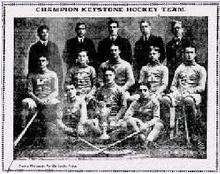Pittsburgh Keystones (ice hockey)
| Pittsburgh Keystones | |
|---|---|
| City | Pittsburgh, Pennsylvania |
| League |
W. Penn Hockey League (1900-1904) Independent (1895-1899) |
| Operated | 1895 - 1903 |
| Home arena |
Duquesne Gardens (1899-1903) Schenley Park Casino (1895-1896) |
| Colors |
Blue, White [1] |
| Championships | |
| Regular season titles | (1) 1901-02 |
The Pittsburgh Keystones were a semi-professional ice hockey club, located in Pittsburgh, Pennsylvania and was a member of the Western Pennsylvania Hockey League, the first league to openly hire hockey players from 1900-1904. The team played all of its games at the Duquesne Gardens, and was involved in allowing Harry Peel become the first admitted professional hockey player in 1902.
History
Pre-1896
The Keystones' history can be traced to the Keystone Bicycle Club, which consisted of students from Western University ( today known as the University of Pittsburgh) and Carnegie Tech. Around 1895 the club gave up bicycling, renamed itself the Pittsburgh Keystones and played ice hockey at the newly built Schenley Park Casino, which was located in the Oakland neighborhood of Pittsburgh, on Saturday afternoons, as an amateur club.[2] On December 30, 1895, the Pittsburgh Press made mention of a “great international hockey and polo tournament” opening game at the Casino. The newspaper reported that a team consisting of ten players from Queen's University played against a group of local players from Western University and Pittsburgh Catholic College of the Holy Ghost (today Duquesne University) and a half hour of exhibition of hockey was played before the ice polo match. The paper noted that 2,500 to 3,000 fans showed up to watch the game, despite claims of bad weather. No score or records were reportedly kept but the paper did note that the team from Queen's University outplayed the Pittsburghers, who had never played the game before. Since the students from Western University participated in the game, it is possible that several of those players later played for the Keystones.
The Casino was destroyed in a fire on December 17, 1896[3] The Yale University hockey team was to have played a series of games against the Keystones, at the Casino, but they were telegraphed and told not to come to Pittsburgh due to the destruction of the arena.[2]
WPHL era

Afterwards, the Keystones, and every other amateur team in Pittsburgh, began playing all of their games on the new ice rink at the Duquesne Gardens. The Gardens, because of its artificial ice surface, lured many established hockey players to the Pittsburgh-area from Canada. In 1901 the team became members of the Western Pennsylvania Hockey League, with the Pittsburgh Bankers and Pittsburgh Athletic Club. Aside from league play, the teams also played exhibition games against some of the best amateur teams from North America.[4] During the 1901-02 season, Riley Hern, a future member of the Hockey Hall of Fame, began his professional career with the Keystones. In his first season, Hern led the league in victories, with nine in 14 games and was named to the WPHL All-Star Team. However, in the next season, Hern led the league in losses, losing 10 out of 11 games.[5] Joining Hern on the team in 1901 was Arthur Sixsmith who moved to Pittsburgh and turning professional with the Keystones.[6] The Keystones would go on to win the 1901-02 WPHL championship title.
First admitted professional player
In the summer of 1902 Keystones' player Harry Peel, a Keystones player in 1901-02, admitted that he was paid $35 a week to play in the so-called amateur league and so no amateur teams would play against these teams again without being suspended by either Canadian or U.S. officials. According to Peel "[The Keystones] make no bones whatever about paying men. If they do not pay them, they give them fake positions." Peel was later suspended by the Ontario Hockey Association and his appeal was rejected on December 10, 1903 and again on November 30, 1904. However, by the 1902-03 season the WPHL, was known as a fully professional league.[4]
Decline
The next season, the Portage Lakes Hockey Club of Houghton, Michigan began a professional league which continued to play professional exhibition game against the WPHL's Pittsburgh Bankers. However the exposure given by playing Portage Lakes raised the profiles of some of the Pittsburgh players, who were lured away after the season for the promise of better pay in Michigan. The team soon raided Pittsburgh’s teams for top players like Riley Hern and Bruce Stuart. This led the Keystones to withdraw from the league on January 17, 1903. Their players were then redistributed among the three other WPHL teams.[7]
Prominent Players
Keystones players inducted into the Hockey Hall of Fame:
- Riley Hern (1963)
Notes
- ↑ "Keystones to take a trip" The Pittsburgh Press, January 10, 1904.
- 1 2 Pittsburgh Hockey Net nd, p. Casino
- ↑ Trietley 2011, p. npg
- 1 2 Fitzsimmons nd, p. npg
- ↑ Hall of Fame nd, p. npg
- ↑ Landucci 1961, p. npg
- ↑ Crashing 2010, p. npg
References
- Trietley, Greg (November 1, 2011). "Oakland Once the Hockey Center of Pittsburgh". Pitt News.
- "1895-1896 Pittsburgh’s Schenley Park Casino". Pittsburgh Hockey.net. Retrieved April 20, 2012.
- Fitzsimmons, Ernie. "Pittsburgh can lay claim to at least a portion of the birth of professional hockey". Pittsburgh Hockey.net. Retrieved April 20, 2012.
- "Riley Hern — Career statistics". Hockey Hall of Fame. Retrieved 2012-04-20.</
- Landucci, Fred (September 27, 1961). "First 'Pros' Start League Play in 1902". Pittsburgh Press.
- "Before the NHL: Western Pennsylvania Hockey League, International Professional Hockey League". Crashing the Net. Retrieved April 20, 2012.
| ||||||||||||||||||
| ||||||||||||||||||||||||||||||||||